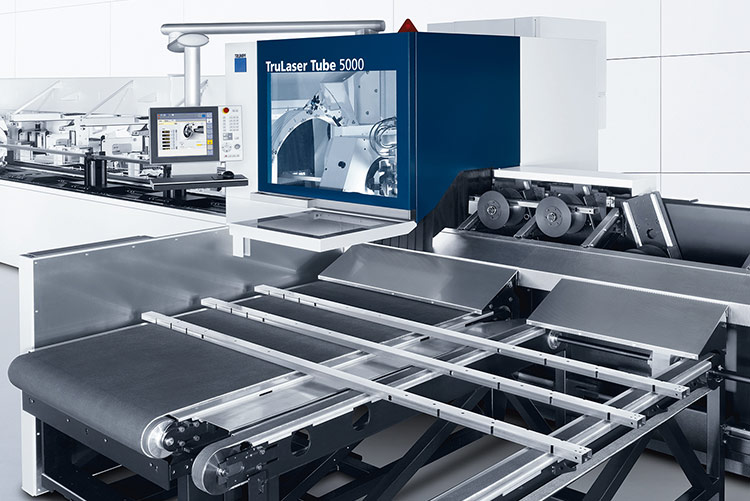The new TruLaser Tube 5000, built by TRUMPF, is a high-productivity, all-round machine to cut tubes with a laser beam. It offers a wealth of innovations. These make the unit even more economical and, in addition, expand its field of application.
A single tool that eliminates four separate procedures. Laser cutting has made this possible, for some time now, in shops that process pipes and tubes. TRUMPF is now presenting the next generation of the TruLaser Tube 5000 at the Tube trade show in Düsseldorf. This machine is based on a time-tested concept and, with its many innovations, makes the first steps into the field of laser tube cutting easy. And it once again boosts profitability. The user enjoys two decisive benefits. On the one hand, the TruLaser Tube 5000 substitutes for four conventional manufacturing procedures: sawing, drilling, milling and deburring. That slashes the amount of organizational effort needed. But this concept also expands design latitude when compared with earlier processes. In the laser cutting systems built by TRUMPF, the lasers themselves, beam guidance, mechanical components, software and automation equipment all stem from the same development setting. This makes sure that all the details of the machine’s central components are fully coordinated one with another, right down to the last detail.
Precise and highly productive
The TruLaser Tube 5000 cuts tubes with walls up to eight millimeters thick and outer circles of up to 152 millimeters in diameter. Thanks to the increased axial speeds and optimized production procedures, the current model is even more productive than the previous machine. The new cutting head with its focal length of 155 millimeters also slices through all the approved gauges. The cutting head need not be changed out, even if the machine works a different material. FocusLine takes care of automatic adjustment of the focal position. This minimizes the time required for set-up.
To achieve the best results in processing, it is important that the tubes and profiles being machined are kept in position, both tightly and without damaging the material. This is taken care of in the TruLaser Tube 5000 by a clamping system incorporating conical rollers and used during both manual and automatic loading. The shape of the rollers automatically centers the tubes and profiles and puts them in the correct position. Here the stress at the point of contact is kept small, because even in rectangular or square tubes, contact is at the outside radius, i.e. at the corners of the profile. A new measurement system monitors the clamping force and the position of the clamping jaws. This increases the accuracy of the holding technique and boosts process reliability when automation is implemented. Along with square, rectangular and oval tubes, the TruLaser Tube 5000 with the optional adaptive clamping method can also handle additional unusual shapes.
Ergonomic and user-friendly
The concept behind the TruLaser Tube 5000 is consistently aligned with utility to the operator. User-friendliness is also in the foreground of the open design. This ensures enhanced accessibility to the working spaces. This will, for example, simplify manual loading if the machine is to make up a single piece from time to time. Control of the machine is carried out easily at a large, pivoted, 17-inch touchscreen. All the important views and elevations can be called up quickly and easily at the clearly organized user interface. TRUMPF developed this GUI especially for laser tube cutting machines.
To permit automated production, the system can be fitted with the LoadMaster Tube loading unit. The input material rests in a bundle space that can be refilled simultaneous to machine operation. Departing that storage area, the tubes pass singly to a conveyor belt. There four grippers lift them and prepare them for loading in the machine. Here the tubing is measured precisely, so that it is in the correct position when passed to the machine. The machine is unloaded via a part removal station. The finished components either pass through a chute into a container or, optionally, can be discharged onto a table fitted with a conveyor belt, at a height convenient for the machine operator to remove them.



